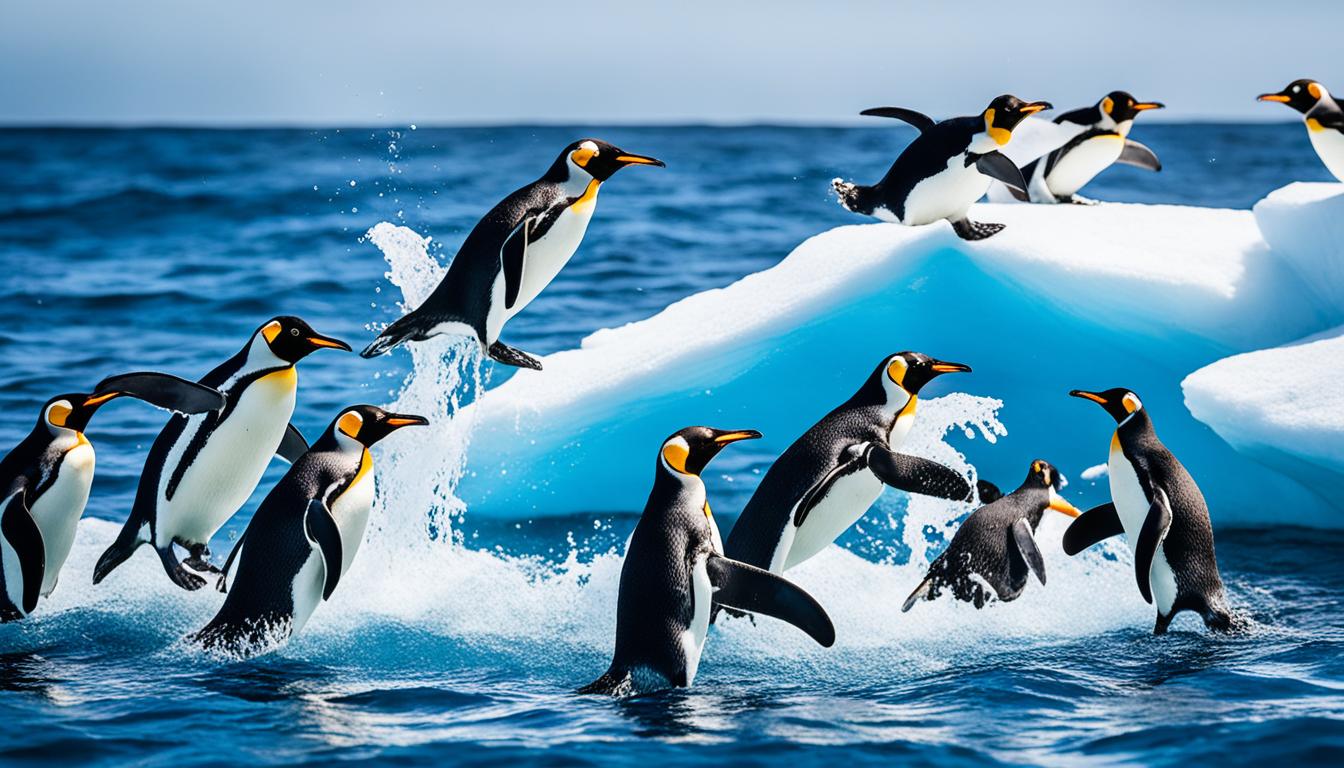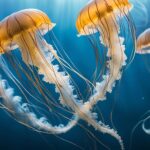Have you ever wondered how penguins find their food? These amazing birds have special ways to live in the water. They mainly eat things like krill, small fish, and squid. Their penguin hunting skills help them find food in the right places near their homes.
Penguins look for food that gives them the most nutrition with the least effort. Sometimes, they even eat jellyfish when other food is hard to find. Working together in groups helps them find and catch more food. Learning about their penguins feeding habits shows us how they survive in the wild.
Penguin Feeding Habits: An Overview
Penguins have unique ways of finding food that help them survive and play a key role in their ecosystems. They eat different things based on their type, where they live, and the environment. Let’s look at what they mainly eat and where they find their food, showing how special these birds are.
Primary Diet
Penguins mainly eat krill, fish, and squid. Different penguin types prefer different foods. For example:
- Adélie penguins mainly eat small krill.
- Chinstrap penguins prefer larger krill.
- King and emperor penguins like fish and squid a lot.
Their eating habits change with the seasons, especially when they’re breeding. Adélie penguins, for example, eat about 1.5 million tons of krill every year. This shows how their big numbers affect the krill population.
Feeding Locations
Penguins go to certain places to find food because that’s where their prey is. They usually hunt in waters 50 to 60 feet deep. Some penguins travel far for food, like Adélie penguins who go about 9 miles, while king penguins can go over 900 miles. This shows that where penguins find food is important and changes with the seasons and their surroundings.
| Penguin Species | Primary Diet | Typical Foraging Depth | Average Distance Travelled for Food |
|---|---|---|---|
| Adélie | Krill | 50-60 feet | ~9 miles |
| Chinstrap | Krill | 50-60 feet | ~20 miles |
| King | Fish, Squid | 50-60 feet | Over 900 miles |
| Emperor | Fish, Squid | 50-60 feet | ~200 miles |
How do penguins hunt for food?
Penguins have amazing ways to find food in tough places. They use different hunting strategies that show their adaptability and skill. These strategies help them survive in harsh environments.
Hunting Strategies and Techniques
Penguins hunt using a mix of techniques, mainly their sharp vision. They use both passive and active methods. Some swim through krill swarms, while others chase fish with great agility. Hunting from below gives them an edge, especially when targeting prey near the surface or under the ice.
Group Foraging Behavior
Group hunting makes penguins more efficient. Species like gentoo and African penguins work together to catch schooling fish. This teamwork can lead to more success in finding food. In groups, penguins may compete for food but also gain from each other’s smarts. They coordinate to surround fish, making their hunt more successful.
| Hunting Strategy | Description | Examples of Penguin Species |
|---|---|---|
| Passive Swimming | Gently moving through schools of krill or small fish. | Emperor Penguin, Fiordland Penguin |
| Active Chasing | Darting and diving to catch fast-moving prey. | Gentoo Penguin, African Penguin |
| Group Foraging | Coordinated efforts to encircle and capture schools of fish. | Gentoo Penguin, Macaroni Penguin |
Penguin Underwater Foraging: Efficiency in Action
Underwater foraging is key to penguins’ survival. They show amazing efficiency in penguin hunting in the water. They use special strategies to find and catch prey well.
Attacks from Below
Penguins attack prey from below in the water. This lets them see better and sneak up on fish schools. The Emperor penguin, for instance, hunts under Antarctic ice, surfacing just below fish when it’s right. This method boosts their hunting success and shows how they adapt in tough places.
Visual Hunting Cues
Watching seabirds like gannets is also crucial for penguins. They notice when these birds show where fish are. This helps penguins hunt better and use their time wisely.
| Hunting Technique | Description | Advantages |
|---|---|---|
| Attacking from Below | Penguins strike upwards at prey from below. | Increased visibility and stealth for better captures. |
| Observing Seabird Activity | Penguins monitor surface behavior of seabirds. | Utilizes environmental cues for efficient foraging. |
Penguin Fishing Techniques: Adaptations and Skills
Penguins have amazing ways to find food in tough places. They have special skills and body changes that help them hunt better. These skills are key to their survival.
Physical Adaptations for Hunting
Penguins have some important physical changes that help them catch food. Their bodies are shaped to cut through the water easily. Here are some key features:
- Spiny tongues: These help grip slippery fish, making it easier for penguins to catch them.
- Powerful jaws: These jaws are strong for breaking hard shells, letting penguins eat different types of food.
- Webbed feet: These feet are great for moving in the water. They help penguins turn quickly and speed up while chasing food.
Stone Swallowing Behavior
Penguins swallow stones, which is a unique behavior. This is seen in king penguins and rockhopper penguins. Swallowing stones helps in several ways:
- Increased diving efficiency: Stones add weight, letting penguins dive deeper to hunt.
- Aiding digestion: Ingested stones may help break down food in the stomach, making nutrients easier to absorb.
- Managing buoyancy: Penguins swallow stones to control their floating in the water. This makes hunting more effective.

These fishing techniques and physical changes show how skilled penguins are as hunters. Their unique ways help them stay efficient and successful in finding food.
Hunting Behavior of Penguins: The Role of Environmental Factors
Penguins’ hunting habits are greatly shaped by their environment. Things like breeding patterns and the availability of food affect their hunting. For example, during breeding seasons, Emperor penguins must travel far to find food because of limited resources.
Polynyas, areas of open water surrounded by sea ice, are key spots for fish and krill. These areas are crucial in winter, when penguins rely on them for food. The difference between these areas and the ice affects how well penguins hunt.
Sea ice and water temperature are big factors in how penguins hunt. Changes in these can change where and how much food is available. So, penguins change their hunting ways to match the food supply. Knowing about these factors helps us see how penguins adapt and survive.
| Environmental Factor | Effect on Hunting Behavior |
|---|---|
| Breeding Patterns | Changes in feeding opportunities, requiring longer foraging trips. |
| Polynyas | Increase access to prey, essential during winter months. |
| Sea Ice Formation | Affects prey availability, leading to modifications in hunting techniques. |
| Water Temperature | Influences the distribution of prey species, forcing penguins to adapt. |
Conclusion: Penguins as Efficient Hunters
Penguins have evolved amazing hunting strategies for their marine homes. They use their streamlined bodies and flipper-like wings to move through the water with ease. These features help them catch fish and krill, which is crucial for their survival.
Group hunting is another key part of their strategy. Penguins work together to catch more prey, showing great teamwork. Their feeding habits and unique methods, like swallowing stones, show how connected they are to their environment.
In summary, penguins are perfect examples of how evolution helps in hunting. They have a wide range of hunting methods and understand their environment well. This shows how important it is to protect their homes to keep these fascinating birds and their role in nature safe.










